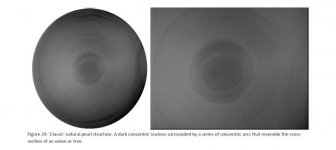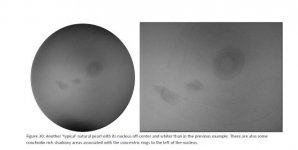GemGeek
Pearlista
You would need x-radiography to see evidence of a tissue graft in a solid nacre cultured pearl. Dave's naturals have a high level of translucency, so they make great subjects for candling. 
The author is not aware of any farms that intentionally produce saltwater NBCPs today or even produced them in the past and no reference to such pearls exist in the major complete or partial pearl texts available (Strack, 2006), (Farn, 1986b), (Taburiaux, 1986), (O'Donoghue, 2006).
Whilst the latter are encountered less frequently, such pearls do exist and are sent to laboratories from time to time. At this point, it is also worth mentioning that the identification of some NBCP is complicated even further by any drill‐holes present and in fact this very process has even been known to be used on saltwater and freshwater NBCPs to try and remove the evidence laboratories use to determine their origin (Crowningshield, 1986b), (Crowningshield, 1986a).
My imagination is running wild with this one; maybe there is a local class of pearlers who deliberately poke young mollusks a couple of times and leave them for the next generation to harvest? No doubt the facts will be more straightforward than that, but who is to say some old timers did not deliberately induce little flesh wounds? In fact, it think it is a logical statement. Those old pearlers knew everything they could learn from personal experience with mollusks in every stage and nuance, and from sharing. Who is to say, at this late date, that they did not know how to create keshi by poking mollusks in the mantle?
There is/was a high(er) incidence of tiny pearls caught in the edges of gulf oyster mantles, so maybe some kind of natural abrasion takes place on the mantle edges to which the mantle responds by creating tiny clumps of nacre? The Gulf has always produced practically tons of those extra tiny pearls compared to the ones 1-2mm or over.
I can imagine a certain few, specialized pearl journeymen staying awake at night figuring out how to get a better harvest. Tinkering year after year. Remembering other examples and how they worked. Man's ability and desire to figure out how to get a better harvest is not limited to aggy graduates, lol
Also, out of curiosity, I would have loved to have seen some examples of undisputed natural pearl internal structures too, so maybe we can get some posted here- a pdf with a lot of examples?....
My methods could always use some refinement, but it's a step in the right direction to better understanding what gives rise to both natural and cultural pearls.
As Blaire (Gemgeek) alluded, I'm very fortunate to have pearls with windows into the past. I can hardly begin to expand on the many hours of wonder peering into these little gems. Each time I revisit this paper and compare signatures in the views, I get a better sense of these voids, which I rarely see in natural pearls.
For others who collect naturals from unknown sources, this is a peril that must be addressed. There is no definitive chemical analysis that describes a distinction between natural or culture pearls from the same species. At this time, the subjectivity of these signatures is all we have to defend this affront. Again, it's not an affirmation of origin, insomuch as a single point of data to help us draw a conclusion.
FP, Do you mean Strack? What I meant was to have some pix on this thread so we don't have to go googling.



